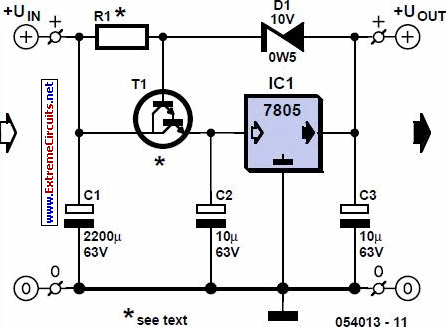FREE
circuits!
How to build Protection For Voltage Regulators
September 30, 2010 - category: Miscellaneous powerCircuit diagram
People often forget that many voltage regulator ICs have an upper limit (usually 35 V) on the input voltage they can handle. That applies primarily to types with a fixed output voltage. Adjustable voltage regulators also have a maximum voltage specification, in that case between the input and output (commonly 40 V). The input voltage must thus be limited to that level in a fault situation in which the output is shorted.
This circuit shows a way to allow such regulators to be used in situations with higher input voltages. Although the solution consists of an additional three components, it is simple and can be built using commonly available components. The voltage across the regulator is limited by the combination of T1 and zener diode D1 to a value that allows the regulator to work properly with loads up to the maximum rated load. R1 provides an adequate operating current for D1 and the bias current for T1.
It’s a good idea to use a Darlington type for T1 in order to keep the value of R1 reasonably high. The current through D1 is only 10 mA with an input voltage of 60 V. Naturally, we also measured what the circuit does when no load is connected. Surprisingly enough, the nominal output voltage of 5.02 V increased to only 5.10 V (with a 60-V input voltage). In our experiments, we used a BDV65B for T1 and a value of 4.7 kO for R1.
If you want to ensure that the circuit is truly short-circuit proof with an input voltage of 60 V, you must use a transistor that remains within its safe operating area at the maximum input voltage with the short-circuit current of the regulator (which can exceed 2 A). The BDV65B and TIP142 do not meet this requirement. The maximum voltage for the BDV65B is actually 40 V, and for the TIP142 is 50 V. If the transistor breaks down, the regulator will also break down. We verified that experimentally.
One possibility is to add SOA protection for T1, but that amounts to protecting the protection. Another option is to relax the requirements. For that purpose, R1 must provide enough current to ensure that T1 receives sufficient current in the event of a short circuit to keep the voltage across T1 lower, but that doesn’t make a lot of difference in practice, and it also increases the minimum load. Besides that, it should be evident that adequate cooling for T1 and IC1 must be provided according to the load.
Ripple suppression is only marginally affected by the protection circuit, since the input is already well stabilized by T1, but the current through D1 does flow through the output. The presence of C2 must also be taken into account. In this circuit, with an adjustable voltage regulator such as the LM317 and an output voltage greater than 40 V, C2 will cause the voltage to be briefly higher than 40 V in the event of a short circuit, which can also cause the IC to be damaged. In that case, it will be necessary to find a different solution or use a different type of voltage regulator.
author: Ton Giesberts, Elektor Electronics Magazine – 07/2005
circuit from http://www.extremecircuits.net/2010/05/protection-for-voltage-regulators.html



 This category
This category